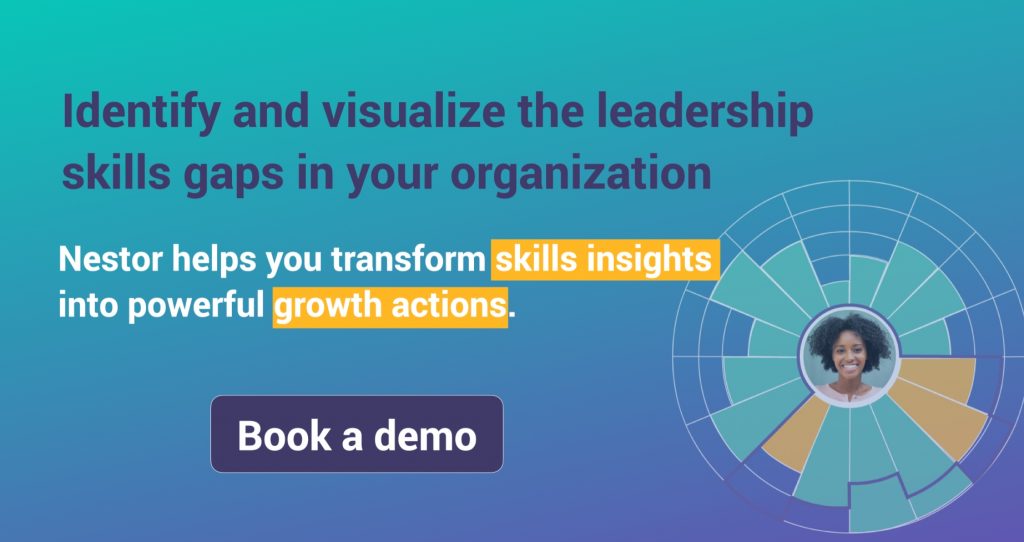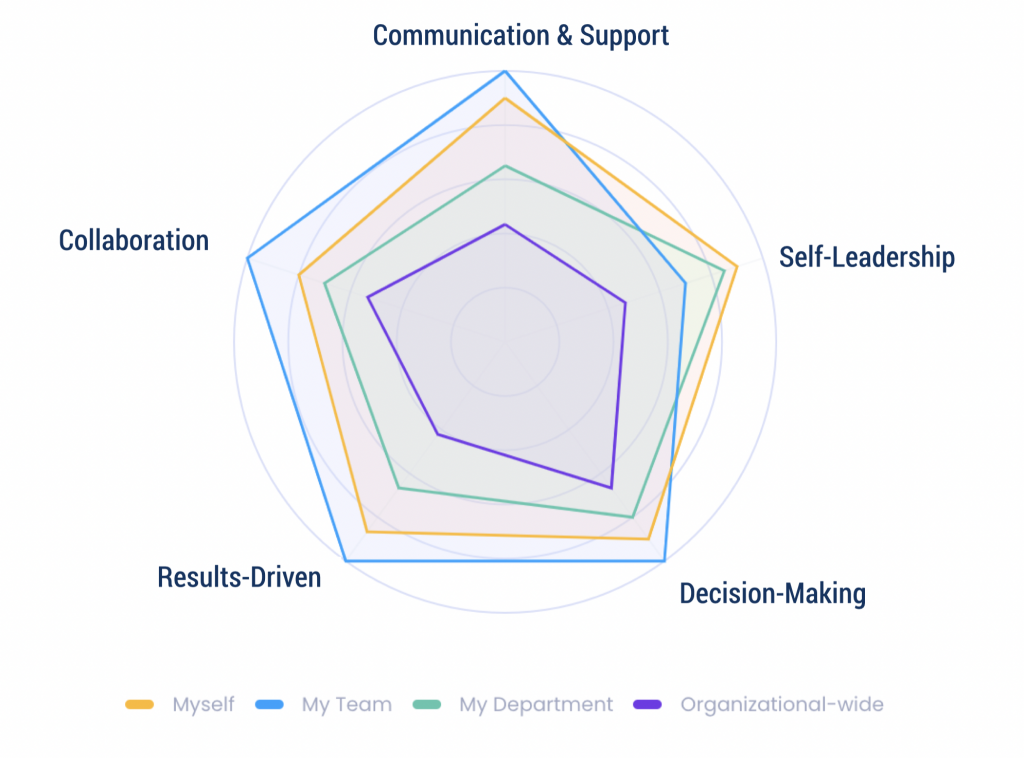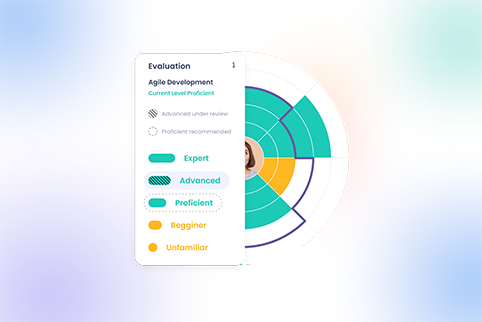How to Identify Potential Leaders Internally and Assess Their Leadership Skills
8 min read

Finding people with leadership skills early on is crucial to the long-term stability of the organization. It helps maintain continuity and facilitates smooth leadership transitions, which prevents disruptions, skill gaps, or the loss of crucial knowledge when experienced employees leave the company.
Actively striving to promote leaders from within will also inspire your people and boost their morale. They will see that opportunities for growth and advancement are available, which will motivate them to push harder and reach the next level of their career.
With that in mind, let’s look at some of the most effective ways to identify potential leaders in your workforce and assess their leadership skills.
1. Define what leadership qualities are essential to your organization
To recognize and nurture the right leaders in your organization, you need to first establish the skills and qualities they need to have in order to align with the broader company culture and vision.
Another thing to keep in mind is that leadership skills are specific abilities that individuals can learn, practice, and refine over time. Common examples are:
- Communication: Leaders need to convey information clearly, listen actively, and foster effective communication within their team.
- Decision-making: Overcoming hesitation and making informed decisions based on critical analysis are crucial in the business world.
- Strategic thinking: Being able to plan for the long term and anticipate future challenges is a must for any potential leader.
- Problem-solving: Analyzing problems and finding the right solution from multiple options is a recurring task for leadership.
- Adaptability: New technologies, ways of work, or even leadership styles — future leaders should respond and embrace them with an open mind.
- Collaboration: Being able to work well with others and helping others work well together is key to achieving common goals in organizations.
Leadership traits vs. leadership skills
Unlike skills, leadership traits are inherent characteristics or personal attributes. While an individual can work on improving these traits, they are more or less natural tendencies that contribute to their effectiveness as a leader. Valuable leadership traits include:
- Integrity: It’s all about having a strong moral compass, being honest, and doing the right thing, even when nobody is looking.
- Confidence: Without believing in one’s abilities and decisions, it’s hard to inspire others to follow your lead.
- Resilience: Challenges and setbacks are part of work and life. Leaders need to know how to bounce back and respond well under pressure.
- Empathy: To work well with others, you need to understand where they’re coming from and connect at an emotional level.
- Courage: True leaders often inspire others through the courage of saying, doing, or standing up for what is right.
- Self-awareness: To lead people, one must be aware of their strengths, weaknesses, and limitations.
- Charisma: Charismatic leaders have a much easier time inspiring others and getting them to follow their lead.

2. Identify employees who have a vision
People who make long-term plans and take action have the potential to be great leaders. You can normally notice this in how they approach day-to-day tasks, but also in their career and personal development plans. Ambitious initiatives in their personal life are great clues as well:
- Are they self-disciplined and invest time in the things that matter to them?
- Do they sacrifice short-term gratification for long-term personal success?
- Are they actively involved in high-responsibility activities in their communities?
- Do they volunteer or stand up for things they believe in?
- Do their actions and behaviors reflect an overall focus on the well-being of others?
If the answer is yes, then congratulations! You’ve got a potential leader on your hands. Here’s how Simon Sinek defines a great leader and their vision:
Great leaders want exactly the same thing. They want to provide their people opportunity, education, discipline when necessary, build their self-confidence, give them the opportunity to try and fail, all so that they could achieve more than we could ever imagine for ourselves.
— Simon Sinek
3. Look at employees displaying the desire to move into leadership roles
Some workers in your organization may already express their intention to take on a leadership position through their actions. These people often:
- Jump at the opportunity to take on novel tasks when these are delegated
- Take the initiative to identify (business) opportunities
- Suggest improvements and alternative ways of doing things
- Bring a list of potential solutions when they mention problems
You can also see this type of people taking time to share tips and tricks with colleagues or simply show them a new tool they’ve found that speeds up the workflow. They display genuine care for their team and are delighted when milestones are achieved.
To be 100% sure and enable a fair and objective assessment of employees displaying leadership potential, you can give succession planning tools a try. They provide a structured and effective way of identifying which members of your workforce are either truly ready to become leaders or could be with additional training and guidance through comprehensive development frameworks.
4. Observe the employees who have the qualities to motivate and influence others
A defining trait of any leader is their ability to inspire and motivate people around them to take action.
People displaying this trait are also generally optimistic and have a positive outlook on life and their careers. They are natural empaths and have a higher EQ (emotional intelligence), which enables them to foster deep connections with their colleagues.
This type of candidate (for future leadership roles) will regularly encourage others to succeed and they’ll celebrate each victory — big or small — with their peers. They will give credit where credit is due and won’t accept praise for work done by others.
5. Examine their overall performance
Identifying leadership skills and potential can sometimes be as easy as observing their general performance over time.
What you should look for is people who constantly demonstrate initiative and take responsibility for their work. These are often top performers or overachievers who go above and beyond their job requirements.
Of course, top performance by itself isn’t enough to qualify someone as a potential leader. You should also examine their ability to handle challenges and make the right decisions independently.
And just as important is their ability to work well with others and even influence or inspire their peers. High-performance levels are great, but not a replacement for true leadership skills — like the ability to collaborate, teach and learn from others, and take the lead when opportunities present themselves.
6. Use leadership surveys and skill assessment tools to find the right leaders
Self-assessment surveys, personality tests, peer feedback, or leadership simulations — these are valuable instruments that can help HR strategists and managers identify, evaluate, and choose employees who can step up and lead others in the future.
Such tools offer comprehensive and in-depth insights that go beyond work performance and touch upon personal traits, aspirations, and soft skills, which are just as important (if not more important) than leadership skills.
These surveys provide valuable insights to inform succession planning strategies, enabling you to groom the right individuals for future leadership positions, ensure a seamless transition, and cultivate a strong pipeline of capable leaders poised for success.
Leadership is not about authority. It’s about inspiring others to follow you and your vision. This is why not everyone who is in a managerial or administrative position is necessarily a true leader.
How to assess leadership skills with Nestor
Don’t leave leadership up to chance! Invest in finding the right people who possess the qualities of great leaders and secure the future success of your organization. With Nestor’s leadership development surveys, you can assess soft skills against key competencies required for the new role from multiple perspectives. Further on you can identify possible gaps and use these insights to promote self-leadership at all levels and empower the rise of new leaders.

These insights will help you understand your people’s strengths and weaknesses and plan to develop their leadership skills and achieve long-term company goals through:
- Career development planning with clear actions for strengthening existing or new capabilities to prepare for a new role;
- Succession planning based on how critical a job position is and its skillset scarcity.
To learn more about the full scope of our platform and how we help organizations attract, develop, and engage top talent, schedule a free demo.







